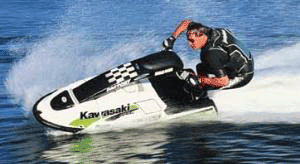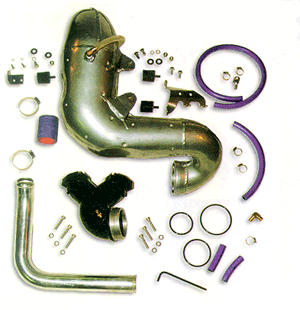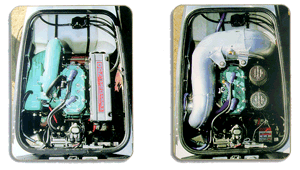 Call (707) 463-1322 to order any Factory Pipe ® product.
Call (707) 463-1322 to order any Factory Pipe ® product. - Products
- Yamaha
- Accessories
- Go-Ped
A DRY IDEA
By Jeff Hain
 When Factory Pipe's head honcho Ross Liberty rang up and said that he had a couple of new pipes for me to try out, I was stoked, to say the least. First off, I hadn't tested a standalone exhaust system on a boat in some time. Sure, I had tested a bunch of different performance kits that included exhaust systems, but I hadn't tested just a pipe on a box stock craft since I tested Factory Pipe's Yamaha GP800 dual pipe exhaust system for the December '98 issue. Okay, so the test with the dual pipe exhaust system on the GP800 also included an R&D Racing Pro Flow Power Plenum flame arrestor and a Riva Yamaha digital CDI, but hey, high flow flame arrestors are the first engine modification that anyone makes to a watercraft, so it was a given. The CDI was a must because of the increased engine revs the dual pipe exhaust system added to the boat. Without the Riva digital CDI, the engine would hit the stock rev limit before reaching its maximum on water rpm.
When Factory Pipe's head honcho Ross Liberty rang up and said that he had a couple of new pipes for me to try out, I was stoked, to say the least. First off, I hadn't tested a standalone exhaust system on a boat in some time. Sure, I had tested a bunch of different performance kits that included exhaust systems, but I hadn't tested just a pipe on a box stock craft since I tested Factory Pipe's Yamaha GP800 dual pipe exhaust system for the December '98 issue. Okay, so the test with the dual pipe exhaust system on the GP800 also included an R&D Racing Pro Flow Power Plenum flame arrestor and a Riva Yamaha digital CDI, but hey, high flow flame arrestors are the first engine modification that anyone makes to a watercraft, so it was a given. The CDI was a must because of the increased engine revs the dual pipe exhaust system added to the boat. Without the Riva digital CDI, the engine would hit the stock rev limit before reaching its maximum on water rpm.
 Well, when Liberty mentioned that one of his new systems used a fully jacketed, dry exhaust chamber and was designed for the SuperJet, I was even more stoked, since I had been riding a SuperJet most of the summer. There was one little problem, however. The all new Factory Pipe SuperJet exhaust system was designed to be run on a Limited or Superstock setup, not on a box stock boat. This meant that whether I tested it on a Limited boat or on a Superstock, a combination of parts would be responsible for the overall gain in horsepower. What would my baseline be? I wanted to know what kind of horsepower the pipe alone was worth not the pipe in conjunction with a set of bigger carbs, more compression, cylinder porting and an aftermarket ignition system.
Well, when Liberty mentioned that one of his new systems used a fully jacketed, dry exhaust chamber and was designed for the SuperJet, I was even more stoked, since I had been riding a SuperJet most of the summer. There was one little problem, however. The all new Factory Pipe SuperJet exhaust system was designed to be run on a Limited or Superstock setup, not on a box stock boat. This meant that whether I tested it on a Limited boat or on a Superstock, a combination of parts would be responsible for the overall gain in horsepower. What would my baseline be? I wanted to know what kind of horsepower the pipe alone was worth not the pipe in conjunction with a set of bigger carbs, more compression, cylinder porting and an aftermarket ignition system.
Liberty's response to my little dilemma was that Factory Pipe was working on a chamber body for the stock SuperJet setup. Unfortunately, it wasn't ready just yet. It would take a minimum of a few weeks. Not good, considering I had some pages to fill and some time on my hands right then.
Okay, so the actual SuperJet exhaust system that I wanted to test wasn't quite ready, but Liberty did say that he had two all new systems. So, what was the other? It was Factory Pipe's all new Kawasaki Jet Ski SXi Dry Pipe exhaust system, and according to Liberty, this system would work on a box stock boat.
That said, we set up a test. Kawasaki's Steve Fischer was kind enough to loan us a brand-new, 2000 model Jet Ski SXi Pro. In a matter of days, I found myself heading north to beautiful Mendocino County, California, home to some of the world's finest vineyards and greatest personal watercraft pipe builders. Believe it or not, both Factory Pipe and Coffman's Exhaust Systems are located in the small Northern California town of Ukiah, about a two hour drive north of the Bay Area.
I flew into Oakland about 8 p.m. and jumped in my rental car. By 10:15, Kawasaki's Tim Lothamer (he has nothing to do with Kawasaki's Jet Ski division other than being a fan of personal watercraft, a huge tech head and the owner of a 750SX Jet Ski, so he joined me on the test) and I were at the back door of Factory Pipe. We were supposed to meet Factory Pipe R&D man John Richards there along with Liberty to do a little late night dyno testing. Nobody was there, which was a complete shock to us, knowing that those two would live in the dyno cell 24/7 if they were allowed.
We tracked down Liberty over at the Holiday Inn, where we would be sleeping within a couple of hours if we had our way.
Liberty was at the hotel talking to Craig Farley (Tera Crismon's mechanic). Farley was up in Ukiah discussing with Liberty the possibility of going to work in Factory Pipe's R&D department.
After dumping our gear in our room, we followed Liberty back over to Factory Pipe. Just minutes after we arrived, Richards showed up. It seems Liberty was kind enough to let him out of the Dyno room at 10 p.m. to grab a quick bite to eat.
Richards already had the SXi Pro's engine on the dyno and ready to be run, complete with the all new Factory Pipe SXi Dry Pipe exhaust system. Through their extensive dyno testing, Factory Pipe has found that the SXi Dry Pipe exhaust system works best with its Electronically Controlled Water Injection (ECWI). Using an MSD Ignition Pulse Width Modulated water controller (which comes with the Factory Pipe SXi Dry Pipe exhaust system), water is injected into the top of the Flat Draft exhaust manifold starting at 3,000 rpm. By 3,500 rpm, the water is fully on. The water injection starts tapering off at 5,000 rpm, and the water is shut off completely by 5,750 rpm.
With the Factory Pipe SXi Dry Pipe exhaust system and a set of Tau Ceti Pro Series flame arrestors installed, the 743cc Kawasaki engine package produced 101 hp at 7,500 rpm. While this didn't exactly meet Factory Pipe's advertised claim of 32 hp over stock, 26 hp for simply bolting on a pipe and a set of flame arrestors is pretty damn impressive especially when you consider that Factory Pipe's old 750SX/SXi exhaust system is only good for 86 hp on the SXi Pro engine package.
Kawasaki claims 75 hp for the SXi Pro engine in stock form, and Richards' dyno runs earlier in the day netted 75.1 hp on Factory Pipe's dyno, or about as close to what Kawasaki claims as you can get. Therefore, I opted not to run the stock exhaust system once we ran the SXi Pro engine with Factory Pipe's SXi Dry Pipe exhaust system. Besides, I knew how fast the stock boat should run, and tomorrow we would be testing the boat on the water with both the Factory Pipe Dry Pipe exhaust system and with the stock exhaust setup.
As impressive as the dyno numbers sound, nothing impresses me more than the actual performance gains that an aftermarket part produces on the water. After all, you don't ride the dyno, do you? On that note, Lothamer and I headed to the hotel for a good night's sleep while Richards stayed up until 4 a.m. disconnecting the engine from the dyno and installing it back in the ski. I wanted to be fresh the next day if I was going to be testing the exhaust system on the water.
The following morning Liberty picked Lothamer and me up at the hotel. The three of us jumped in Liberty's car and headed south down the 101 to Hopland, a small town about 15 to 20 minutes south of Ukiah. We were checking out a small private lake where we have tested in the past. The lake, known as Lake Maha, is used for irrigation of the Vineyards that surround it, as well as for slalom water skiing, for which it was originally designed. Liberty had heard that the water level of the lake was down, so he wanted to see if we would be able to test there before we dragged down the ski and all of the equipment. Unfortunately, the water level was too low, so we headed back to Factory Pipe where we met up with Richards, Farley and Factory Pipe sales guru Robert Hirko. We would then all make our way to Ukiah's Lake Mendocino, about 5 minutes from the Factory Pipe shop, but only after some extensive modifications to the SXi Pro's stock hood. It seems that when Factory Pipe was developing the SXi Dry Pipe they used both an SXi and an SXi Pro. What they didn't realize was that the engine in the SXi Pro is slightly farther forward, compared to that of the SXi. Because the SXi Pro that they used for development was a Superstock with a high flow aftermarket hood, the pipe fit as it did on the standard SXi. Unfortunately, on our box stock test boat (hood and all) the Factory Pipe Dry Pipe wouldn't allow the hood to close completely. After removing the two air intake hoses from the bottom side of the hood (which you have to do) and taking a cutoff wheel and die grinder to the underside of the hood as well, we were able to clearance the hood so that it would fit. Liberty said that the chamber body on all new pipes would be modified so that grinding of the front part of the hood would not be necessary. On the SXi and SXi Pro, however, you still will have to grind out a section on the underside of the hood where the rear rubber intake hose is located. You also have to modify the foam around the fuel tank at the front, right-hand portion of the engine compartment. A pre bent and heated up hacksaw blade works ideally for this.
 While the elevation of Mendocino isn't too bad, at approximately 600 feet above sea level, sometimes it can get blown out. Fortunately on this day, there wasn't anyone else on the water, and the wind never came up. Since Farley, Lothamer and I were the only three on hand who could actually ride a standup at speed, Farley volunteered (sort of) to ride the ski while I pulled the trigger on the radar gun.
While the elevation of Mendocino isn't too bad, at approximately 600 feet above sea level, sometimes it can get blown out. Fortunately on this day, there wasn't anyone else on the water, and the wind never came up. Since Farley, Lothamer and I were the only three on hand who could actually ride a standup at speed, Farley volunteered (sort of) to ride the ski while I pulled the trigger on the radar gun.
After multiple runs and a little fine tuning of the carbs, the SXi Pro with the Factory Pipe Dry Pipe exhaust system had an average top speed of 52.76 mph. The 0 to 20 mph acceleration time of the ski was 1.55 seconds, with a 20 to 35 mph acceleration time of 1.64 seconds. The ski took 10.94 seconds to get from idle in the water to its top speed, and the engine turned a peak onwater rpm of 7,620. Farley hit a onetime peak speed on the gun of 53.04 mph.
Once we finished the acceleration runs with the Factory Pipe system installed, I jumped on the boat to make a few top speed passes at the gun and to play around on the ski for a bit. Like Farley, I was able to hit a onetime peak speed on the gun of 53.04 mph. Considering that flame arrestors and the exhaust system were the only mods we had made to the boat, I was impressed. Right off the bottom, the ski seemed to slip the impeller. On the big end you could definitely tell that the boat was under propped, not only from our tach readings, but also from riding it. I could occasionally feel the impeller cavitating in the corners.
Once finished radaring and riding the SXi Pro with the Factory Pipe and the Tau Cetis, Richards and Farley swapped the exhaust systems out while the rest of us looked on. With the two of them spinning wrenches they had the Factory Pipe off and the stock exhaust system back in place in about an hour. Other than having to change out the main jets in the carburetors, the two systems are interchangeable. With the Factory Pipe Dry Pipe exhaust system, the stock 147.5 main jets have to be changed out to a 170 main jet in the rear carb and a 172.5 main jet in the front carb. The high speed adjustment screw on each carburetor also has to be set from 7/8 of a turn out to 1 3/4 turns out. The Factory Pipe system also uses a larger water bypass fitting. The fitting, which is a direct replacement for the OE fitting, uses a 1/2 inch waterline as compared to the stock 5/16 inch line. The Factory Pipe system also comes with a 1/2 inch waterline to replace the stock 3/8 inch incoming cooling hose.
In stock form, the SXi Pro had a top speed of 48.3 mph with a 0 to 20 mph acceleration time of 2.16 seconds. Acceleration of the stock SXi Pro from 20 to 35 mph took 1.64 seconds. The boat reached its top speed from idle in the water in 10.47 seconds. The peak on water engine speed of the ski in stock form was 6,940 rpm, some 680 rpm less than the boat turned with the Factory Pipe.
Other than the fact that we had to mangle the stock hood on the SXi Pro and that the triple O-ring design coupler between the head pipe and the chamber body did show some signs of seepage (I believe it was just assembly grease and not exhaust fumes, as the boat pulled 7620 rpm and ran great, but still it didn't look very good) out on the water, the system gave us what we were looking for. It gave the SXi Pro much better out of the hole acceleration, improved midrange performance and a gain of over 4 mph on the big end. On glass smooth water with the stock intake grate and ride plate, that is about all the SXi Pro can handle.
Although I'm pretty certain that with the right handling package, some more compression (our test ski had a cranking compression of 160 psi per cylinder) and the right impeller pitch, even better acceleration and maybe a couple of more miles per hour could be had easily.
Now that I actually have a baseline on the system, maybe I can find a Superstock ski onto which to bolt the Dry Pipe exhaust system to get some real arm jerking numbers. pwi
reprinted with permission
Tel: 707-463-1322, Fax: 707-463-1384, E-mail: Click here